Yujie Lin
Learnable Sequence Augmenter for Triplet Contrastive Learning in Sequential Recommendation
Mar 26, 2025Abstract:Most existing contrastive learning-based sequential recommendation (SR) methods rely on random operations (e.g., crop, reorder, and substitute) to generate augmented sequences. These methods often struggle to create positive sample pairs that closely resemble the representations of the raw sequences, potentially disrupting item correlations by deleting key items or introducing noisy iterac, which misguides the contrastive learning process. To address this limitation, we propose Learnable sequence Augmentor for triplet Contrastive Learning in sequential Recommendation (LACLRec). Specifically, the self-supervised learning-based augmenter can automatically delete noisy items from sequences and insert new items that better capture item transition patterns, generating a higher-quality augmented sequence. Subsequently, we randomly generate another augmented sequence and design a ranking-based triplet contrastive loss to differentiate the similarities between the raw sequence, the augmented sequence from augmenter, and the randomly augmented sequence, providing more fine-grained contrastive signals. Extensive experiments on three real-world datasets demonstrate that both the sequence augmenter and the triplet contrast contribute to improving recommendation accuracy. LACLRec significantly outperforms the baseline model CL4SRec, and demonstrates superior performance compared to several state-of-the-art sequential recommendation algorithms.
Investigating Inference-time Scaling for Chain of Multi-modal Thought: A Preliminary Study
Feb 17, 2025Abstract:Recently, inference-time scaling of chain-of-thought (CoT) has been demonstrated as a promising approach for addressing multi-modal reasoning tasks. While existing studies have predominantly centered on text-based thinking, the integration of both visual and textual modalities within the reasoning process remains unexplored. In this study, we pioneer the exploration of inference-time scaling with multi-modal thought, aiming to bridge this gap. To provide a comprehensive analysis, we systematically investigate popular sampling-based and tree search-based inference-time scaling methods on 10 challenging tasks spanning various domains. Besides, we uniformly adopt a consistency-enhanced verifier to ensure effective guidance for both methods across different thought paradigms. Results show that multi-modal thought promotes better performance against conventional text-only thought, and blending the two types of thought fosters more diverse thinking. Despite these advantages, multi-modal thoughts necessitate higher token consumption for processing richer visual inputs, which raises concerns in practical applications. We hope that our findings on the merits and drawbacks of this research line will inspire future works in the field.
Hypergraph-Based Dynamic Graph Node Classification
Dec 29, 2024



Abstract:Node classification on static graphs has achieved significant success, but achieving accurate node classification on dynamic graphs where node topology, attributes, and labels change over time has not been well addressed. Existing methods based on RNNs and self-attention only aggregate features of the same node across different time slices, which cannot adequately address and capture the diverse dynamic changes in dynamic graphs. Therefore, we propose a novel model named Hypergraph-Based Multi-granularity Dynamic Graph Node Classification (HYDG). After obtaining basic node representations for each slice through a GNN backbone, HYDG models the representations of each node in the dynamic graph through two modules. The individual-level hypergraph captures the spatio-temporal node representations between individual nodes, while the group-level hypergraph captures the multi-granularity group temporal representations among nodes of the same class. Each hyperedge captures different temporal dependencies of varying lengths by connecting multiple nodes within specific time ranges. More accurate representations are obtained through weighted information propagation and aggregation by the hypergraph neural network. Extensive experiments on five real dynamic graph datasets using two GNN backbones demonstrate the superiority of our proposed framework.
A Dual-Perspective Metaphor Detection Framework Using Large Language Models
Dec 23, 2024Abstract:Metaphor detection, a critical task in natural language processing, involves identifying whether a particular word in a sentence is used metaphorically. Traditional approaches often rely on supervised learning models that implicitly encode semantic relationships based on metaphor theories. However, these methods often suffer from a lack of transparency in their decision-making processes, which undermines the reliability of their predictions. Recent research indicates that LLMs (large language models) exhibit significant potential in metaphor detection. Nevertheless, their reasoning capabilities are constrained by predefined knowledge graphs. To overcome these limitations, we propose DMD, a novel dual-perspective framework that harnesses both implicit and explicit applications of metaphor theories to guide LLMs in metaphor detection and adopts a self-judgment mechanism to validate the responses from the aforementioned forms of guidance. In comparison to previous methods, our framework offers more transparent reasoning processes and delivers more reliable predictions. Experimental results prove the effectiveness of DMD, demonstrating state-of-the-art performance across widely-used datasets.
Synchronized and Fine-Grained Head for Skeleton-Based Ambiguous Action Recognition
Dec 19, 2024



Abstract:Skeleton-based action recognition using GCNs has achieved remarkable performance, but recognizing ambiguous actions, such as "waving" and "saluting", remains a significant challenge. Existing methods typically rely on a serial combination of GCNs and TCNs, where spatial and temporal features are extracted independently, leading to an unbalanced spatial-temporal information, which hinders accurate action recognition. Moreover, existing methods for ambiguous actions often overemphasize local details, resulting in the loss of crucial global context, which further complicates the task of differentiating ambiguous actions. To address these challenges, we propose a lightweight plug-and-play module called Synchronized and Fine-grained Head (SF-Head), inserted between GCN and TCN layers. SF-Head first conducts Synchronized Spatial-Temporal Extraction (SSTE) with a Feature Redundancy Loss (F-RL), ensuring a balanced interaction between the two types of features. It then performs Adaptive Cross-dimensional Feature Aggregation (AC-FA), with a Feature Consistency Loss (F-CL), which aligns the aggregated feature with their original spatial-temporal feature. This aggregation step effectively combines both global context and local details. Experimental results on NTU RGB+D 60, NTU RGB+D 120, and NW-UCLA datasets demonstrate significant improvements in distinguishing ambiguous actions. Our code will be made available at https://github.com/HaoHuang2003/SFHead.
MLDGG: Meta-Learning for Domain Generalization on Graphs
Nov 19, 2024

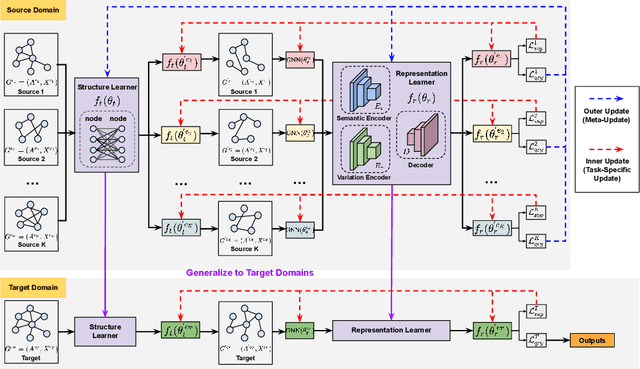
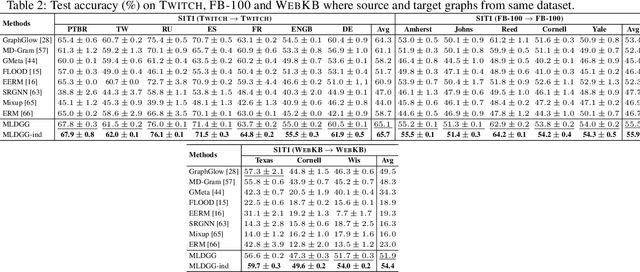
Abstract:Domain generalization on graphs aims to develop models with robust generalization capabilities, ensuring effective performance on the testing set despite disparities between testing and training distributions. However, existing methods often rely on static encoders directly applied to the target domain, constraining its flexible adaptability. In contrast to conventional methodologies, which concentrate on developing specific generalized models, our framework, MLDGG, endeavors to achieve adaptable generalization across diverse domains by integrating cross-multi-domain meta-learning with structure learning and semantic identification. Initially, it introduces a generalized structure learner to mitigate the adverse effects of task-unrelated edges, enhancing the comprehensiveness of representations learned by Graph Neural Networks (GNNs) while capturing shared structural information across domains. Subsequently, a representation learner is designed to disentangle domain-invariant semantic and domain-specific variation information in node embedding by leveraging causal reasoning for semantic identification, further enhancing generalization. In the context of meta-learning, meta-parameters for both learners are optimized to facilitate knowledge transfer and enable effective adaptation to graphs through fine-tuning within the target domains, where target graphs are inaccessible during training. Our empirical results demonstrate that MLDGG surpasses baseline methods, showcasing its effectiveness in three different distribution shift settings.
Towards Cross-Modal Text-Molecule Retrieval with Better Modality Alignment
Oct 31, 2024Abstract:Cross-modal text-molecule retrieval model aims to learn a shared feature space of the text and molecule modalities for accurate similarity calculation, which facilitates the rapid screening of molecules with specific properties and activities in drug design. However, previous works have two main defects. First, they are inadequate in capturing modality-shared features considering the significant gap between text sequences and molecule graphs. Second, they mainly rely on contrastive learning and adversarial training for cross-modality alignment, both of which mainly focus on the first-order similarity, ignoring the second-order similarity that can capture more structural information in the embedding space. To address these issues, we propose a novel cross-modal text-molecule retrieval model with two-fold improvements. Specifically, on the top of two modality-specific encoders, we stack a memory bank based feature projector that contain learnable memory vectors to extract modality-shared features better. More importantly, during the model training, we calculate four kinds of similarity distributions (text-to-text, text-to-molecule, molecule-to-molecule, and molecule-to-text similarity distributions) for each instance, and then minimize the distance between these similarity distributions (namely second-order similarity losses) to enhance cross-modal alignment. Experimental results and analysis strongly demonstrate the effectiveness of our model. Particularly, our model achieves SOTA performance, outperforming the previously-reported best result by 6.4%.
GDDA: Semantic OOD Detection on Graphs under Covariate Shift via Score-Based Diffusion Models
Oct 23, 2024Abstract:Out-of-distribution (OOD) detection poses a significant challenge for Graph Neural Networks (GNNs), particularly in open-world scenarios with varying distribution shifts. Most existing OOD detection methods on graphs primarily focus on identifying instances in test data domains caused by either semantic shifts (changes in data classes) or covariate shifts (changes in data features), while leaving the simultaneous occurrence of both distribution shifts under-explored. In this work, we address both types of shifts simultaneously and introduce a novel challenge for OOD detection on graphs: graph-level semantic OOD detection under covariate shift. In this scenario, variations between the training and test domains result from the concurrent presence of both covariate and semantic shifts, where only graphs associated with unknown classes are identified as OOD samples (OODs). To tackle this challenge, we propose a novel two-phase framework called Graph Disentangled Diffusion Augmentation (GDDA). The first phase focuses on disentangling graph representations into domain-invariant semantic factors and domain-specific style factors. In the second phase, we introduce a novel distribution-shift-controlled score-based generative diffusion model that generates latent factors outside the training semantic and style spaces. Additionally, auxiliary pseudo-in-distribution (InD) and pseudo-OOD graph representations are employed to enhance the effectiveness of the energy-based semantic OOD detector. Extensive empirical studies on three benchmark datasets demonstrate that our approach outperforms state-of-the-art baselines.
Fair Data Generation via Score-based Diffusion Model
Jun 13, 2024



Abstract:The fairness of AI decision-making has garnered increasing attention, leading to the proposal of numerous fairness algorithms. In this paper, we aim not to address this issue by directly introducing fair learning algorithms, but rather by generating entirely new, fair synthetic data from biased datasets for use in any downstream tasks. Additionally, the distribution of test data may differ from that of the training set, potentially impacting the performance of the generated synthetic data in downstream tasks. To address these two challenges, we propose a diffusion model-based framework, FADM: Fairness-Aware Diffusion with Meta-training. FADM introduces two types of gradient induction during the sampling phase of the diffusion model: one to ensure that the generated samples belong to the desired target categories, and another to make the sensitive attributes of the generated samples difficult to classify into any specific sensitive attribute category. To overcome data distribution shifts in the test environment, we train the diffusion model and the two classifiers used for induction within a meta-learning framework. Compared to other baselines, FADM allows for flexible control over the categories of the generated samples and exhibits superior generalization capability. Experiments on real datasets demonstrate that FADM achieves better accuracy and optimal fairness in downstream tasks.
Supervised Algorithmic Fairness in Distribution Shifts: A Survey
Feb 05, 2024
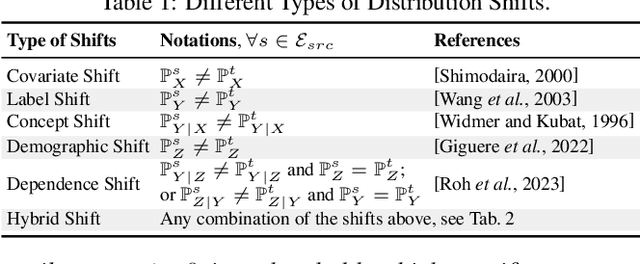
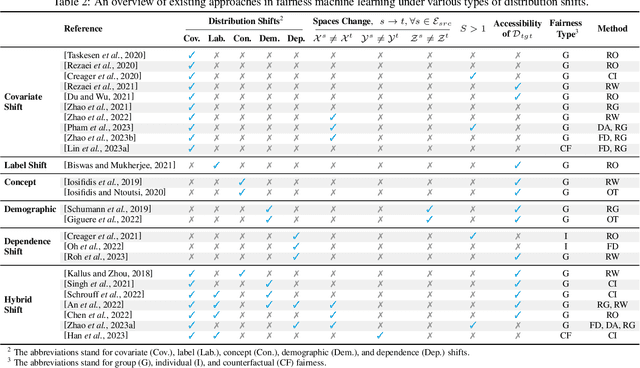
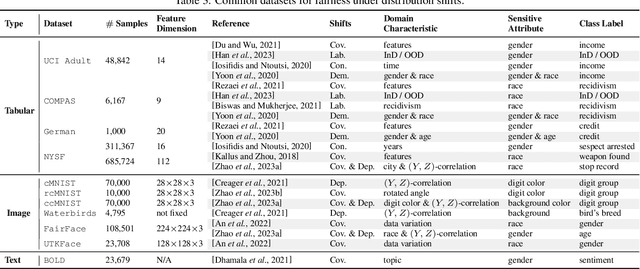
Abstract:Supervised fairness-aware machine learning under distribution shifts is an emerging field that addresses the challenge of maintaining equitable and unbiased predictions when faced with changes in data distributions from source to target domains. In real-world applications, machine learning models are often trained on a specific dataset but deployed in environments where the data distribution may shift over time due to various factors. This shift can lead to unfair predictions, disproportionately affecting certain groups characterized by sensitive attributes, such as race and gender. In this survey, we provide a summary of various types of distribution shifts and comprehensively investigate existing methods based on these shifts, highlighting six commonly used approaches in the literature. Additionally, this survey lists publicly available datasets and evaluation metrics for empirical studies. We further explore the interconnection with related research fields, discuss the significant challenges, and identify potential directions for future studies.
 Add to Chrome
Add to Chrome Add to Firefox
Add to Firefox Add to Edge
Add to Edge